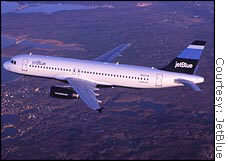NEW YORK (CNN/Money) -
While low-fare carriers will carry more passengers this holiday season than ever before, the fastest growing segment of the airline industry is facing more serious financial problems than ever before.
 |
|
| Analysts forecast JetBlue will post its first loss as a public company this quarter. |
JetBlue Airways (Research) is now forecasted to post its first quarterly loss as a public company, while ATA Airlines (Research)' woes forced it to file for bankruptcy court protections last month. Independence Air (Research), which only started operations as a stand-alone carrier in June, may not be far behind -- its said in a Securities and Exchange Commission filing that it could be forced into bankruptcy unless it can renegotiate about $80 million in aircraft lease payments due in January.
All these problems come as the low-fare carriers are estimated by consultant Back Aviation to be carrying 25 percent of U.S. domestic air travelers this year, up from 24 percent in 2003 and 13.5 percent ten years ago.
The rising cost of fuel is the main culprit pointed to by most of the low-fare carriers. In September, the most recent month for which industry data is available, the average cost of Jet fuel was about $1.24 a gallon, up 55 percent from year-earlier levels.
Low-fare leader Southwest Airlines (Research) has protection from the rising cost of fuel with long-term fuel contracts for more than 80 percent of its fuel needs at less than half of current prices. No other low-fare carriers have that, and some have no long-term fuel purchase deals, leaving them as vulnerable on fuel, the second largest cost behind labor, as the more troubled old line airlines.
Revenge of the old line airlines
But several of the troubled carriers are also complaining about competition on fares from traditional airlines, which have struggled to respond to the low-fare airlines.
| Related stories
|

|
|
|
|
"It's too much competition from companies that are purposely allowing themselves to lose money," said Rick DiLisi, spokesman for Independence Air. "Companies in bankruptcy right now, such as United and US Air, have been significantly slashing their own fares. Our primary competitors are those two companies."
JetBlue executives also point to the low fares, especially on coast-to-coast routes, from so-called "legacy carriers," such as United, American Airlines and Delta Air Lines. Analysts agree that the efforts of the current fare structures of the legacy carriers is at least part of problem leading to red ink on both sides of the battle between old line carriers and the upstart low-fare segment.
"The big guys decided they wanted to maintain market share in areas where they didn't have the cost structure to compete," said Ray Neidl, analyst with Calyon Securities. "It's adjusting slowly as the big guys decide they'll never make money there."
But analysts and executives such as JetBlue Chairman and CEO David Neeleman argue that the combination of low fares and high fuel prices can not continue into next year.
"Some of the capacity will go away if fuel prices stay this high," said Betsy Snyder, airline credit analyst for Standard & Poor's. "It (oil prices near $50 a barrel) could hasten US Airways' demise."
| 
| |

| 
| 
|

|
 A record number of travelers are expected to hit the road this holiday season. CNN's Jason Carroll takes a look at what you can expect. A record number of travelers are expected to hit the road this holiday season. CNN's Jason Carroll takes a look at what you can expect.
|
 Play video
Play video
(Real or Windows Media)
|
| 
|

|
|
Independence Air says it's hopeful it'll be able to renegotiate its leases and stay out of bankruptcy. But Snyder and Neidl both express skepticism about its prospects and plans, which call for using smaller regional jets instead of the traditional full-size narrow body jets.
"With these fuel prices, they've gone through cash quickly," said Snyder. "Their strategy might work, but the question is if they have enough time to test it."
ATA's chances of recovery are also cloudy. It's also trying to renegotiate aircraft leases signed during the airline industry's boom times of the late 1990s. It is retreating from its hub at Chicago Midway Airport, for example, where it faces growing competition from Southwest.
Low-fare segment to still grow
Another low-fare carrier, Atlanta-based AirTran Airways (Research) has negotiated a deal to buy ATA's gates at Midway. But other carriers, including Southwest, are also eyeing those gates. AirTran has its own financial problems, posting its first loss since early 2002 in the third quarter. Forecasts expect it'll also lose money in the current and upcoming periods.
"Even with that loss, we're fortunate that our cost structure is such that we can move when opportunity presents itself," said AirTran spokeswoman Judy Graham-Weaver.
Analysts say the trend of more market share going to the low-fare carriers will not be reversed by the sector's current problems. But they say the success that many low-fare airlines have had in recent years has blinded some people to the challenges they face against entrenched airlines and forces outside their control, such as fuel spikes.
"There's certainly been a history of low-fare carries going by the wayside," said Snyder, referring to airlines such as PeopleExpress and Midway Airlines.
"I think the trend towards low fares is definitely here to stay," she said.
Click here for a look at airline stocks
It's less clear that all of today's low-fare airlines will be able to stay around with them.

|

